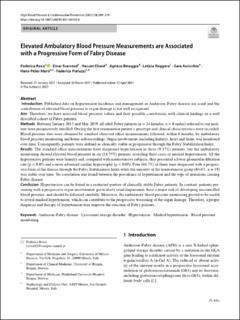Elevated Ambulatory Blood Pressure Measurements are Associated with a Progressive Form of Fabry Disease
Rossi, Federica; Svarstad, Einar; Elsaid, Hassan; Binaggia, Agnese; Roggero, Letizia; Auricchio, Sara; Marti, Hans-Peter; Pieruzzi, Federico
Journal article, Peer reviewed
Published version

Åpne
Permanent lenke
https://hdl.handle.net/11250/2823532Utgivelsesdato
2021Metadata
Vis full innførselSamlinger
- Department of Clinical Medicine [2029]
- Registrations from Cristin [9423]
Originalversjon
High Blood Pressure & Cardiovascular Prevention. 2021, 28, 309-319. 10.1007/s40292-021-00450-0Sammendrag
Introduction
Published data on hypertension incidence and management in Anderson–Fabry disease are scant and the contribution of elevated blood pressure to organ damage is not well recognized.
Aim
Therefore, we have assessed blood pressure values and their possible correlations with clinical findings in a well described cohort of Fabry patients.
Methods
Between January 2015 and May 2019, all adult Fabry patients (n = 24 females, n = 8 males) referred to our institute were prospectively enrolled. During the first examination patient’s genotype and clinical characteristics were recorded. Blood pressure data were obtained by standard observed office measurements followed, within 6 months, by ambulatory blood pressure monitoring and home self-recordings. Organ involvement, including kidneys, heart and brain, was monitored over time. Consequently, patients were defined as clinically stable or progressive through the Fabry Stabilization Index.
Results
The standard office measurements have diagnosed hypertension in three (9.37%) patients, but the ambulatory monitoring showed elevated blood pressure in six (18.75%) patients, revealing three cases of masked hypertension. All the hypertensive patients were females and, compared with normotensive subjects, they presented a lower glomerular filtration rate (p < 0.05) and a more advanced cardiac hypertrophy (p < 0.05). Four (66.7%) of them were diagnosed with a progressive form of the disease through the Fabry Stabilization Index while the majority of the normotensive group (84.6%, n = 19) was stable over time. No correlation was found between the prevalence of hypertension and the type of mutations causing Fabry disease.
Conclusion
Hypertension can be found in a restricted portion of clinically stable Fabry patients. In contrast, patients presenting with a progressive organ involvement, particularly renal impairment, have a major risk of developing uncontrolled blood pressure, and should be followed carefully. Moreover, the ambulatory blood pressure monitoring proved to be useful to reveal masked hypertension, which can contribute to the progressive worsening of the organ damage. Therefore, a proper diagnosis and therapy of hypertension may improve the outcome of Fabry patients.
